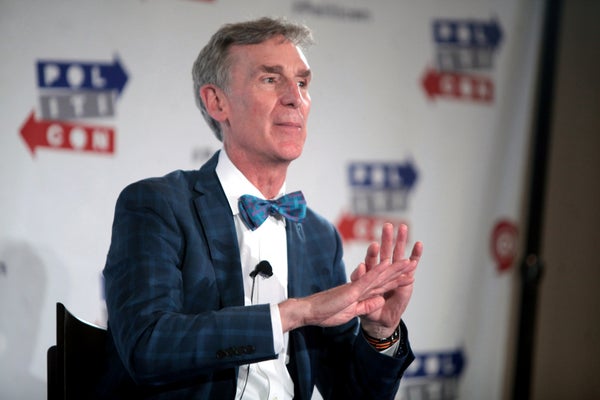To ensure a bright future, Americans need to engage with science. Yet the incoming Trump administration has just picked Scott Pruitt, a fossil fuel industry ally, to head the Environmental Protection Agency. President-elect Donald Trump has also promised to roll back environmental regulations such as the Clean Power Plan, to gut the EPA and to renege on the Paris climate agreement. Meanwhile the planet continues to warm, sea levels keep rising and glaciers retreat even farther.So how should scientists and science communicators respond? And how can they persuade citizens who are skeptical about climate change that man-made global warming is real and that nations need to act?
Scientific American sought answers from Bill Nye. He developed a global following during his 1990s children’s TV show, Bill Nye, the Science Guy, and is CEO of The Planetary Society. He is now also a centennial ambassador for the U.S. National Park Service.
[An edited transcript of the interview follows.]
On supporting science journalism
If you're enjoying this article, consider supporting our award-winning journalism by subscribing. By purchasing a subscription you are helping to ensure the future of impactful stories about the discoveries and ideas shaping our world today.
Donald Trump has called climate change a hoax, and has promised to roll back environmental regulations. How should the science community respond going forward?
Well, let’s see what happens. My experience, as a listener to Mr. Trump, is that he says extraordinary things that he doesn’t always stick with.
But I hope the common ground between Trump and the science community is innovation—it’s what keeps the United States in the game economically. If you want jobs, if you want to improve infrastructure, then investment in basic research is what will give it to you. The United States doesn’t manufacture things the way it did in, say, my father’s time. Instead, we export these fabulous ideas—like iPhone software and the internet. So conservatives have more in common with progressives than they might realize when it comes to investing in business. I hope that continues.
Beyond Trump, how do you engage people with science when they can’t even agree on the most fundamental facts?
I think that’s slowly changing. People are more engaged in science than they have been in decades. In particular, we’ll see what happens when millennials come of age and they’re running the show. I think we will find that they are more scientifically literate than we were 20 or 30 years ago. I’ll take full responsibility for that, with The Science Guy show—I am being ironic, of course.
Is there anything that scientists and science educators could do to better engage the public with issues such as global warming?
As changes in the environment become more apparent, more people will get onboard the environmental bandwagon. When you visit a national park, for example, you will see evidence of climate change. If we want to change the name to “Dusty Hillside National Park” instead of Glacier National Park, that’s fine—but I kind of prefer Glacier National Park. I think if you visit a place like that, you’ll see the problem immediately. You can see where the glacier used to be, and you can see where it is today. You can see the astonishing devastation to the pine trees in Montana and Idaho from beetles—a species that used to be frozen out, but winters are no longer cold enough to inhibit its rapid propagation.
So as people see evidence of climate change, they’ll change their minds?
Yes. The trouble is that climate change [occurs] in slow motion. It doesn’t have that one catastrophic moment. But I think people will get onboard eventually.
The other thing is to say to conservatives: if we really want to invest in national infrastructure, if we really want to have energy independence, then we need to invest in renewable energy infrastructure. Those jobs cannot be outsourced. You might be able to buy turbine blades in another country, but you can’t erect a turbine in the U.S. from anywhere but in the U.S. So the opportunities in renewable energy are huge, and I believe everybody will figure that out and get to work on this.
